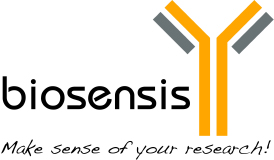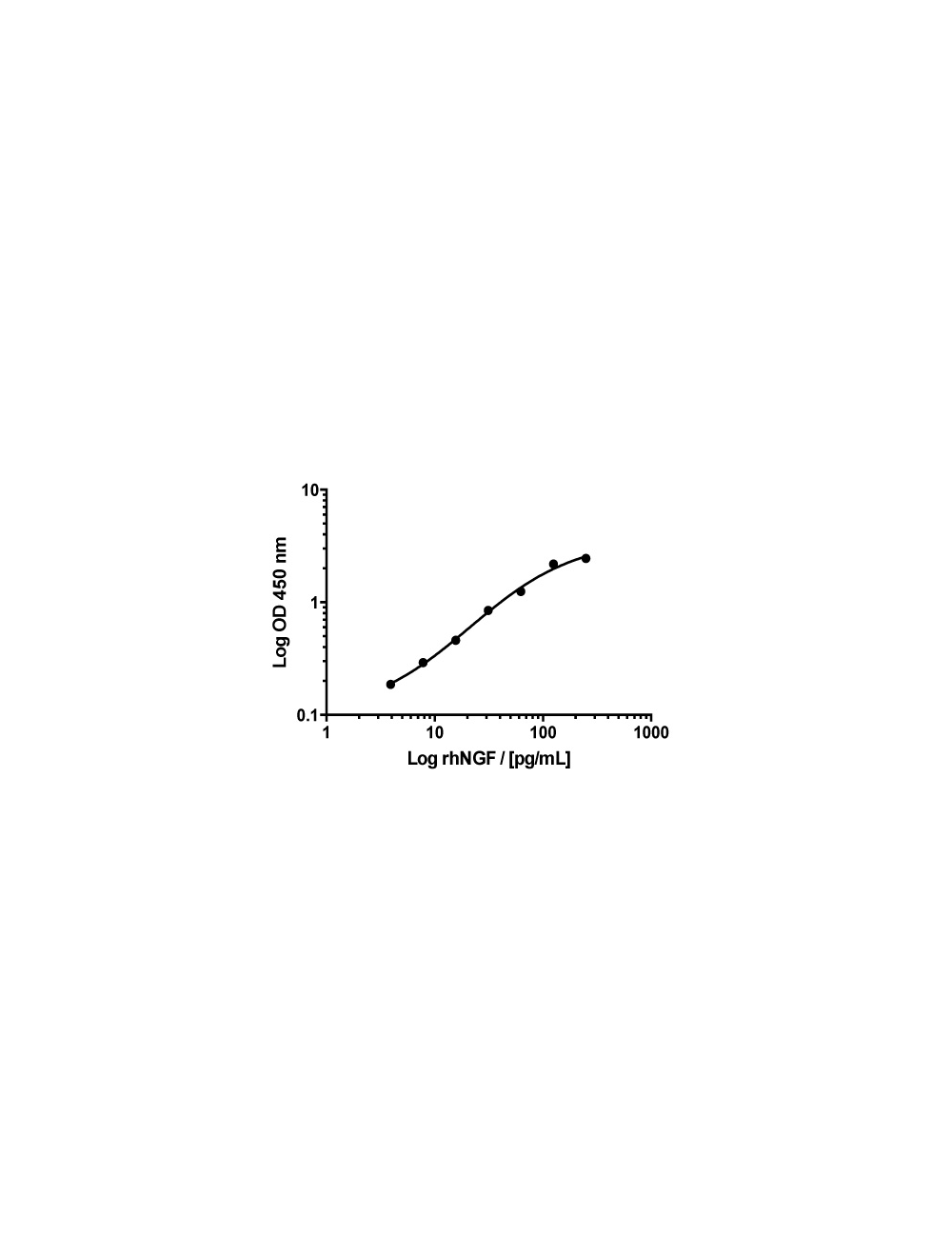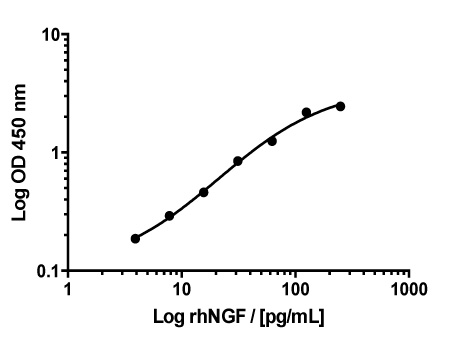Nerve growth factor (Beta-NGF), Human, Rapid™ ELISA assay
- Product Name Nerve growth factor (Beta-NGF), Human, Rapid™ ELISA assay
-
Product Description
The Biosensis NGF RapidTM enzyme-linked immunosorbent assay (ELISA) Kit is a sandwich ELISA that allows the quantification of human NGF in less than 3 hours in cell culture supernatants, serum, plasma (citrate) and brain extracts only if used as directed. Please refer to the kit protocol for specific use instructions for each substrate application, in particular serum and plasma samples.
This ELISA kit consists of a pre-coated mouse monoclonal anti-NGF capture antibody, a biotinylated anti-NGF detection antibody and horseradish peroxidase (HRP)-conjugated streptavidin. The addition of a substrate 3,3',5,5'-tetramethylbenzidine, TMB yields a colored reaction product which is directly proportional to the concentration of NGF present in samples and protein standards. A human NGF positive control (QC sample) is provided to assure consistent assay performance.
This NGF ELISA kit is designed to measure human NGF and thus employs a recombinant human NGF standard approved by the World Health Organization (WHO). Due to a high degree of NGF sequence homology, the antibodies used in this kit will also detect NGF from numerous other species including mouse and rat!
The antibodies used in this ELISA kit bind epitopes within the mature domain of the protein and therefore can recognize both the pro- and the mature form of NGF. However, internal validation data demonstrates <0.1% cross-reactivity (determined at 25 ng/mL, diluted in assay buffer) with human proNGF protein, suggesting the preferential quantification of mature NGF over full-length human proNGF
Note that accurate NGF quantification in human citrate-plasma requires the addition of Heterophilic Antibody Blocker BL-005-500 provided in the kit, and available for purchase separately.
This kit has not been tested for other applications. It has been configured for research use only and is not to be used in diagnostic or clinical procedures. - Alternative Names Beta-nerve growth factor; Ngfb; NGF;
- Application(s) ELISA
- Species Reactivity Human
- Immunogen Description Recombinant human NGF, made in CHO cells (WHO reference reagent)
- Range 3.9 - 250 pg/mL
- Sensitivity Typical limit of detection (LOD) for human NGF is 2 pg/mL determined as 150% of the blank value.
- Regulatory Status For research use only.
Product Info
-
Product Description
The Biosensis NGF RapidTM enzyme-linked immunosorbent assay (ELISA) Kit is a sandwich ELISA that allows the quantification of human NGF in less than 3 hours in cell culture supernatants, serum, plasma (citrate) and brain extracts only if used as directed. Please refer to the kit protocol for specific use instructions for each substrate application, in particular serum and plasma samples.
This ELISA kit consists of a pre-coated mouse monoclonal anti-NGF capture antibody, a biotinylated anti-NGF detection antibody and horseradish peroxidase (HRP)-conjugated streptavidin. The addition of a substrate 3,3',5,5'-tetramethylbenzidine, TMB yields a colored reaction product which is directly proportional to the concentration of NGF present in samples and protein standards. A human NGF positive control (QC sample) is provided to assure consistent assay performance.
This NGF ELISA kit is designed to measure human NGF and thus employs a recombinant human NGF standard approved by the World Health Organization (WHO). Due to a high degree of NGF sequence homology, the antibodies used in this kit will also detect NGF from numerous other species including mouse and rat!
The antibodies used in this ELISA kit bind epitopes within the mature domain of the protein and therefore can recognize both the pro- and the mature form of NGF. However, internal validation data demonstrates <0.1% cross-reactivity (determined at 25 ng/mL, diluted in assay buffer) with human proNGF protein, suggesting the preferential quantification of mature NGF over full-length human proNGF
Note that accurate NGF quantification in human citrate-plasma requires the addition of Heterophilic Antibody Blocker BL-005-500 provided in the kit, and available for purchase separately.
This kit has not been tested for other applications. It has been configured for research use only and is not to be used in diagnostic or clinical procedures. -
Related Products
Nerve growth factor, pro- (proNGF), Human, Rapid™ ELISA assay
Mature NGF/proNGF Combo (BEK-2212/2226), Human, Rapid™ ELISA assay
Heterophilic antibody blocker for BEK-2212 and similar ELISA assays
- Application(s) ELISA
- Application Details ELISA. For the quantification of Nerve growth factor (Beta-NGF) in Culture Supernatant, Serum, Plasma (Citrate), Tissue Homogenates. Please download the detailed product insert for complete instructions for the successful use of this ELISA. Use only as directed.
- Target Nerve growth factor (Beta-NGF)
-
Target Cross-Reactivity (ELISA)
The antibodies used in this ELISA kit bind epitopes within the mature domain of the protein and therefore can recognize both the pro- and the mature form of NGF. However, human proNGF protein shows <0.1% cross-reactivity (determined at 25 ng/mL, diluted in assay buffer), suggesting the preferential quantification of mature NGF over full-length human proNGF.
This NGF ELISA does not cross-react with brain derived neurotrophic factor (BDNF), neurotrophin-3 (NT-3), NT-4/5, glial cell line-derived neurotrophic factor (GDNF) and vascular endothelial growth factor (VEGF165) tested at 25 ng/mL. Due to a high degree of NGF sequence homology, the antibodies used in this kit will also detect mature NGF from numerous other species including mouse and rat! - Target Host Species Human
- Species Reactivity Human
- Immunogen Description Recombinant human NGF, made in CHO cells (WHO reference reagent)
- Range 3.9 - 250 pg/mL
- Sensitivity Typical limit of detection (LOD) for human NGF is 2 pg/mL determined as 150% of the blank value.
- Sample Type Culture Supernatant, Plasma (Citrate), Serum, Tissue Homogenates
- Detection Method Colorimetric
- Kit Components The ELISA kit box contains 96-well pre-coated strip plate(s), protein standards, QC sample, detection reagents, wash and sample buffers, substrate buffer and detailed protocols.
- Storage Instructions Store at 2-8°C
- Storage Temperature 2-8°C
- Batch Number Please see item label.
- Expiration Date 12 months from purchase.
- Alternative Names Beta-nerve growth factor; Ngfb; NGF;
- Uniprot Number P01138
- Uniprot Number/Name P01138 (NGF_HUMAN)
- Scientific Background FUNCTION: Nerve growth factor is important for the development and maintenance of the sympathetic and sensory nervous systems. It stimulates division and differentiation of sympathetic and embryonic sensory neurons. SUBUNIT: Homodimer, associated by non-covalent forces. SUBCELLULAR LOCATION: Secreted protein. SIMILARITY: Belongs to the NGF-beta family.
- Shipping Statement For order quantities larger than 1 plate, this product is supplied in package units of 2 plates.
- Shipping Temperature 2-8°C (on cold packs)
- UNSPSC CODE 41116158
- Regulatory Status For research use only.
Specifications
-
Specific References
Kania K et al. (2024) Predicting clinical progression and cognitive decline in patients with relapsing-remitting multiple sclerosis: a 6-year follow-up study Neurol. Neurochir. Pol. Ahead of Print Application: Human Peripheral Blood
Loch AA et al. (2023). Plasma levels of neurotrophin 4/5, NGF and pro-BDNF influence transition to mental disorders in a sample of individuals at ultra-high risk for psychosis Psychiatry Res. [Epub ahead of print]. Application: Human plasma (EDTA).
Pathare-Ingawale P et al. (2023) Association between proNGF receptors and apoptotic factors in human placentae Placenta. [Epub ahead of print]. Application: Human, placental tissue lysates.
Chen S et al. (2022) Newly Generated 3D Schwann-Like Cell Spheroids From Human Adipose-Derived Stem Cells Using a Modified Protocol. Cell Transplant. 31:9636897221093312. Application: Human cell culture supernatant.
Chen S et al. (2021) Effective in vitro differentiation of adipose-derived stem cells into Schwann-like cells with folic acid supplementation. J Med Investig. Vol. 68. Application: Human cell culture supernatant.
March B et al. (2021) ELISA-based quantification of neurotrophic growth factors in urine from prostate cancer patients. FASEB Bioadv. [Epub ahead of print]. Application: Human urine.
Mossa AH et al. (2020) Imbalance of nerve growth factor metabolism in aging women with overactive bladder syndrome. World J Urol. [Epub ahead of print]. Application: Human urine.
Sumiyoshi E et al. (2019) Sub-Chronic Consumption of Dark Chocolate Enhances Cognitive Function and Releases Nerve Growth Factors: A Parallel-Group Randomized Trial. Nutrients. 11(11). Application: Human Plasma.
Sherif IO & Al-Gayyar MMH (2018) Oleuropein potentiates anti-tumor activity of cisplatin against HepG2 through affecting proNGF/NGF balance. Life Sci. [Epub ahead of print]. Application: Human cell culture.

 1800 605-5127
1800 605-5127 +61 (0)8 8352 7711
+61 (0)8 8352 7711


